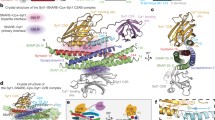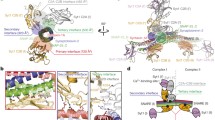Abstract
Although the binding of synaphin (also called complexin) to the soluble N-ethylmaleimide-sensitive factor attachment protein receptor (SNARE) complex is critical for synaptic vesicle exocytosis, the exact role of synaphin remains unclear. Here, we show that synaphin directly binds to synaptotagmin 1, a major Ca2+ sensor for fast neurotransmitter release, in a 1:1 stoichiometry. Mapping of the synaphin site involved in synaptotagmin 1 binding revealed that the C-terminal region is essential for the interaction between these two proteins. Binding was sensitive to ionic strength, suggesting the involvement of charged residues in the C-terminus region. Mutation of the seven consecutive glutamic acid residues (residues 108–114) at the C-terminal region of synaphin to alanines or glutamines resulted in a dramatic reduction in synaptotagmin 1 binding activity. Furthermore, a peptide from the C-terminus of synaphin (residues 91–124) blocked the binding of synaptotagmin 1 to synaphin, an effect that was abolished by mutating the consecutive glutamic acid residues to alanine. Immunoprecipitation experiments with brain membrane extracts showed the presence of a complex consisting of synaphin, synaptotagmin 1, and SNAREs. We propose that synaphin recruits synaptotagmin 1 to the SNARE-based fusion complex and synergistically functions with synaptotagmin 1 in mediating fast synaptic vesicle exocytosis.








Similar content being viewed by others
References
Augustine, G. J. (2001). How does calcium trigger neurotransmitter release? Curr. Opin. Neurobiol. 11, 320–326.
Augustine, G. J., Burns, M. E., DeBello, W. M., Hilfiker, S., Morgan, J. R., Schweizer, F. E., Tokumaru, H., and Umayahara, K. (1999). Proteins involved in synaptic vesicle trafficking. J. Physiol. 520, 33–41.
Bracher, A., Kadlec, J., Betz, H., and Weissenhorn, W. (2002). X-ray structure of a neuronal complexin-SNARE complex from squid. J. Biol. Chem. 277, 26517–26523.
Chapman, E. R. (2002). Synaptotagmin: a Ca2+ sensor that triggers exocytosis? Nat. Rev. Mol. Cell. Biol. 3, 498–508.
Chen, X., Tomchick, D. R., Kovrigin, E., Arac, D., Machius, M., Südhof, T. C., and Rizo, J. (2002). Three-dimensional structure of the complexin/SNARE complex. Neuron 33, 397–409.
Davis, A. F., Bai, J., Fasshauer, D., Wolowick, M. J., Lewis, J. L., and Chapman, E. R. (1999). Kinetics of synaptotagmin responses to Ca2+ and assembly with the core SNARE complex onto membrane. Neuron 24, 363–376.
DiAntonio, A., Parfitt, K. D., and Schwarz, T. L. (1993). Synaptic transmission persists in synaptotagmin mutants of Drosophila. Cell 73, 1281–1290.
Geppert, M., Goda, Y., Hammer R. E., Li, C., Rosahl, T. Stevens, C. F., and Südhof, T. C. (1994). Synaptotagmin I: a major Ca2+ sensor for transmitter release at a central synapse. Cell 79, 717–727.
Giraudo, C. G., Eng, W. S., Melia, T. J., and Rothman, J. E. (2006). A clamping mechanism involved in SNARE-dependent exocytosis. Science 313, 676–680.
Guan, R., Dai, H., and Rizo, J. (2008). Binding of the Munc13–1 MUN domain to membrane-anchored SNARE complexes. Biochemistry 47, 1474–1481.
Hu, K., Carroll, J., Rickman, C., and Davletov, B. (2002). Action of complexin on SNARE complex. J. Biol. Chem. 277, 41652–41656.
Huntwork, S. and Littleton, J. T. (2007). A complexin fusion clamp regulates spontaneous neurotransmitter release and synaptic growth. Nat. Neurosci. 10, 1235–1237.
Ishizuka, T., Saisu, H., Odani, S., and Abe, T. (1995). Synaphin: a protein associated with the docking/fusion complex in presynaptic terminals. Biochem. Biophys. Res. Commun. 213, 1107–1114.
Ishizuka, T., Saisu, H., Odani, S., Kumanishi, T., and Abe, T. (1999). Distinct regional distribution in the brain of messenger RNAs for the two isoforms of synaphin associated with the docking/fusion complex. Neuroscience 88, 295–306.
Itakura, M., Misawa, H., Sekiguchi, M., Takahashi, S., and Takahashi, M. (1999). Transfection analysis of functional roles of complexins I and II in the exocytosis of two different types of secretory vesicles. Biochem. Biophys. Res. Commun. 265, 691–696.
Jahn, R., Lang, T., and Südhof, T. C. (2003). Membrane fusion. Cell 112, 519–533.
Jahn, R. and Scheller, R. H. (2006). SNAREs - engines for membrane fusion. Nat. Rev. Mol. Cell Biol. 7, 631–643.
Koh, T. W. and Bellen, H. J. (2003). Synaptotagmin I, a Ca2+ sensor for neurotransmitter release. Trends Neurosci. 26, 413–422.
Leveque, C., Boudier, J.A., Takahashi, M. and Seagar, M. (2000). Calcium-dependent dissociation of synaptotagmin from synaptic SNARE complexes. J. Neurochem. 74, 367–374.
Li, Y., Augustine, G. J., and Weninger, K. (2007). Kinetics of complexin binding to the SNARE complex: correcting single molecule FRET measurements for hidden events. Biophys. J. 93, 2178–2187.
Li, C., Ullrich, B., Zhang, J. Z., Anderson, R. G., Brose, N. and Südhof, T. C. (1995). Ca2+-dependent and -independent activities of neural and non-neural synaptotagmins. Nature 375, 594–599.
Littleton, J. T., Bai, J., Vyas, B., Desai, R., Baltus, A. E., Garment, M. B., Carlson, S. D., Ganetzky, B., and Chapman, E. R. (2001). Synaptotagmin mutants reveal essential functions for the C2B domain in Ca2+-triggered fusion and recycling of synaptic vesicles in vivo. J. Neurosci. 21, 1421–1433.
Littleton, J. T., Stern, M., Schulze, K., Perin, M., and Bellen, H. J. (1993). Mutational analysis of Drosophila synaptotagmin demonstrates its essential role in Ca2+-activated neurotransmitter release. Cell 74, 1125–1134.
Martens, S., Kozlov, M. M., and McMahon, H. T. (2007). How synaptotagmin promotes membrane fusion. Science 316, 1205–1208.
Melia, T. J. (2007). Putting the clamps on membrane fusion: How complexin sets the stage for calcium-mediated exocytosis. FEBS Lett. 581, 2131–2139.
McMahon, H. T., Missler, M., Li, C., and Südhof, T. C. (1995). Complexins: cytosolic proteins that regulate SNAP receptor function. Cell 83, 111–119.
Nishiki, T., Kamata, Y., Nemoto, Y., Omori, A., Ito, T., Takahashi, M., and Kozaki, S. (1994). Identification of Protein receptor for clostridium botulinum type B neurotoxin in rat brain synaptosomes. J. Biol. Chem. 269, 10498–10503.
Nonet, M. L., Grundahl, K., Meyer, B. J., and Rand, J. B. (1993). Synaptic function is impaired but not eliminated in C. elegans mutants lacking synaptotagmin. Cell 73, 1291–1305.
Pabst, S., Hazzard, J. W., Antonin, W., Südhof, T. C., Jahn, R., Rizo, J., and Fasshauer, D. (2000). Selective interaction of complexin with the neuronal SNARE complex. Determination of the binding regions. J. Biol. Chem. 275, 19808–19818.
Pabst, S., Margittai, M., Vainius, D., Langen, R., Jahn, R. and Fasshauer, D. (2002). Rapid and selective binding to the synaptic SNARE complex suggests a modulatory role of complexins in neuroexocytosis. J. Biol. Chem. 277, 7838–7848.
Perin, M. S., Fried, V. A., Mignery, G. A., Jahn, R., and Südhof, T. C. (1990). Phospholipid binding by a synaptic vesicle protein homologous to the regulatory region of protein kinase C. Nature 345, 260–263.
Pobbati, A. V., Stein, A., and Fasshauer, D. (2006) N- to C-terminal SNARE complex assembly promotes rapid membrane fusion. Science 313, 673–676.
Reim, K., Mansour, M., Varoqueaux, F., McMahon, H. T., Südhof, T. C., Brose, N., and Rosenmund, C. (2001). Complexins regulate a late step in Ca2+-dependent neurotransmitter release. Cell 104, 71–81.
Reim, K., Wegmeyer, H., Brandstätter, J. H., Xue, M., Rosenmund, C., Dresbach, T., Hofmann, K., and Brose, N. (2005). Structurally and functionally unique complexins at retinal ribbon synapses. J. Cell Biol. 169, 669–680.
Rizo, J., Chen, X., and Arac, D. (2006). Unraveling the mechanisms of synaptotagmin and SNARE function. Trends Cell Biol. 16, 339–350.
Rothman, J. E. (1994). Mechanisms of intracellular protein transport. Nature 372, 55–63.
Schaub, J. R., Lu, X., Doneske, B., Shin, Y. K., and McNew, J. A. (2006). Hemifusion arrest by complexin is relieved by Ca2+-synaptotagmin I. Nat. Struct. Mol. Biol. 13, 748–750.
Schiavo, G., Stenbeck, G., Rothman, J. E. and Söllner, T. (1997). Binding of the synaptic vesicle v-SNARE, synaptotagmin, to the plasma membrane t-SNARE, SNAP–25, can explain docked vesicles at neurotoxin-treated synapses. Proc. Natl. Acad. Sci. USA. 94, 997–1001.
Südhof, T. C. (2002). Synaptotagmins: why so many? J. Biol. Chem. 277, 7629–7632.
Südhof, T. C. (2004). The synaptic vesicle cycle. Annu. Rev. Neurosci. 27, 509–547.
Sutton, R. B., Fasshauer, D., Jahn, R., and Brunger, A. T. (1998). Crystal structure of a SNARE complex involved in synaptic exocytosis at 2.4 Å resolution. Nature 395, 347–353.
Takahashi, S., Yamamoto, H., Matsuda, Z., Ogawa, M., Yagyu, K., Taniguchi, T., Miyata, T., Kaba, H., Higuchi, T., Okutani, F., and Fujimoto, S. (1995). Identification of two highly homologous presynaptic proteins distinctly localized at the dendritic and somatic synapses. FEBS Lett. 368, 455–460.
Tang, J., Maximov, A., Shin, O.-H., Dai, H., Rizo, J., and Südhof, T. C. (2006). A complexin/synaptotagmin 1 switch controls fast synaptic vesicle exocytosis. Cell 126, 1175–1187.
Tokumaru, H., Umayahara, K., Pellegrini, L. L., Ishizuka, T., Saisu, H., Betz, H., Augustine, G. J., and Abe, T. (2001). SNARE complex oligomerization by synaphin/complexin is essential for synaptic vesicle exocytosis. Cell 104, 421–432.
Tokumaru, H., Abe, T., Gee, K. R., Bonewald, L., and Augustine, G. J. (2002). Timing of Synaphin/Complexin action in neurotransmitter release probed by a caged binding-site peptide. Abstr. Soc. Neurosci. 28, 66.
Tucker, W. C., Weber, T., and Chapman, E. R. (2004). Reconstitution of Ca2+-regulated membrane fusion by synaptotagmin and SNAREs. Science 304, 435–438.
Weber, T., Zemelman, B. V., McNew, J. A., Westermann, B., Gmachl, M., Parlati, F., Söllner, T. H., and Rothman, J. E. (1998). SNAREpins minimal machinery for membrane fusion. Cell 92, 759–772.
Weninger, K., Bowen, M. E., Choi, U. B., Chu, S., and Brunger, A. T. (2008). Accessory proteins stabilize the acceptor complex for synaptobrevin, the 1:1 syntaxin/SNAP–25 complex. Structure 16, 308–320.
Wojcik, S. M., and Brose, N. (2007). Regulation of membrane fusion in synaptic excitation-secretion coupling: speed and accuracy matter. Neuron. 5, 11–24.
Xue, M., Reim, K., Chen, X., Chao, H.-T., Deng, H., Rizo, J., Brose, N., and Rosenmund, C. (2007). Distinct domains of complexin I differentially regulate neurotransmitter release. Nat. Struct. Mol. Biol. 14, 949–958.
Yoshida, A., Oho, C., Omori, A., Kuwahara, R., Ito, T., and Takahashi, M. (1992). HPC-1 is associated with synaptotagmin and ω-conotoxin receptor. J. Biol. Chem. 267, 24925–24928.
Yoshihara, M., and Littleton, J. T. (2002). Synaptotagmin I functions as a calcium sensor to synchronize neurotransmitter release. Neuron 36, 897–908.
Zhang, X., Kim-Miller, M. J., Fukuda, M., Kowalchyk, J. A., and Martin, T. F. J. (2002). Ca2+-dependent synaptotagmin binding to SNAP-25 is essential for Ca2+-triggered exocytosis. Neuron 34, 599–611.
Acknowledgments
We thank M. Takahashi (Kitasato University, Sagamihara, Japan) for supplying the monoclonal antibodies to Syt1 and syntaxin 1, and M. Watanabe (Tokushima Bunri University) for mass spectrometric analysis of the bound proteins. We also thank Y. Li (Stanford University) for his critical reading of this manuscript. This work was supported in part by grants (to H. T., and T. A.) from the Ministry of Education, Culture, Sports, Science, and Technology of Japan, and from the Takeda Science Foundation.
Author information
Authors and Affiliations
Corresponding author
Rights and permissions
About this article
Cite this article
Tokumaru, H., Shimizu-Okabe, C. & Abe, T. Direct interaction of SNARE complex binding protein synaphin/complexin with calcium sensor synaptotagmin 1. Brain Cell Bio 36, 173–189 (2008). https://doi.org/10.1007/s11068-008-9032-9
Received:
Revised:
Accepted:
Published:
Issue Date:
DOI: https://doi.org/10.1007/s11068-008-9032-9




